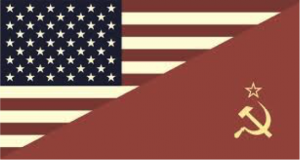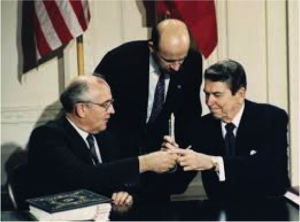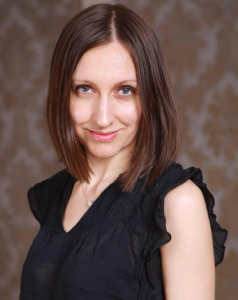by Olga Krasnyak
U.S.-Soviet exchanges in the Cold War
Given the ambiguity of the rapidly changing world order, scholars and practitioners are paying more attention to the Cold War period, with its growing relevance for contemporary world politics. Issues such as the NATO alliance, human rights, arms control, and environment impact international relations at large and U.S.-Russia relations in particular. The need to re-emphasize the value of scientists as a channel of communication between governments and their research communities is urgent.[i]
 The state of U.S.-Russia relations is currently at one of its lower points. Political relations continue to be strained. The Intermediate-Range Nuclear Forces Treaty (INF) signed by Reagan and Gorbachev in 1987 has been abandoned, bringing the world into a new era of uncertainty. In both countries, the official narratives revolve around an adversarial image about the other. Relations are in a vicious cycle of suspicion, mistrust, and mutual hostility.
The state of U.S.-Russia relations is currently at one of its lower points. Political relations continue to be strained. The Intermediate-Range Nuclear Forces Treaty (INF) signed by Reagan and Gorbachev in 1987 has been abandoned, bringing the world into a new era of uncertainty. In both countries, the official narratives revolve around an adversarial image about the other. Relations are in a vicious cycle of suspicion, mistrust, and mutual hostility.
In the post-1945 world amid Cold War tensions, however, the U.S. and the Soviet Union were able to negotiate on a number of issues, even when relations were deadlocked and the two superpowers were on the brink of nuclear war.
Cold War diplomacy produced critical armament control treaties — the Non-Proliferation Treaty (NPT), the Anti-Ballistic Missile Treaty (ABM), and the Intermediate-Range Nuclear Forces Treaty (INF) to name but a few. In all these cases, scientific and technical people-to-people exchanges were critical for enabling communication and dialogue.
People-to-people exchanges began with the ‘Lacy-Zarubin Agreement’ signed in 1957. The agreement reinforced scientific contacts in space and medicine,[ii] and laid out the terms for exchanges between the two parties in what evolved into an Interacademy Scientific Exchanges agreement renewable every two to three years.[iii] In the following decades, the agreement remained unbroken. The latest agreement was prepared in 1984[iv] but finalized two years later.[v] The exchanges were symmetrical. If an American delegation visited the Soviet Union for a joint conference, then a Soviet delegation visited the U.S. for a similar joint conference.
The exchanges had a positive impact on bilateral relations and wider implications in world politics. State leaders — Nixon and Brezhnev in the early years of détente and Reagan and Gorbachev by the end of the Cold War — whether driven by domestic or international politics or both, ultimately aimed to improve relations and sustain a peaceful coexistence.

How did communication and cooperation between American and Soviet scientists and diplomats help prevent war, lead to arms control agreements, and address global challenges? Jack F. Matlock, a former Ambassador to the Soviet Union who promoted people-to-people exchanges, saw them as a key component to create opportunities to foster mutual trust. As the Matlock archives now at Duke University show, sincere interpersonal communication made it possible to understand other interests and recognize intentions, helping to improve relations, prevent war, and reduce existing international conflicts. The establishment of true ‘doveriye’ (trust) was also the intention expressed by the Soviet side.
Matlock argued that personal contacts impact the human mind when people make decisions. Thus, long-lasting personal encounters between American and Soviet scientists and engineers (and between state leaders too) were a foundation for effective cooperation.[vi] Interpersonal communication was eventually transformative in world politics.
Scientific exchanges in the lens of foreign policy, diplomacy, and intelligence
However, even while the scientific exchanges were relatively open, adversarial relations restricted cooperation between Soviet and American scientists. The intelligence agencies’ operations contradicted the notion of academic freedom and open exchange of information. The CIA and KGB kept all scientific contact under their control.[vii]
The role of scientists — whether or not they were being used in international politics, or even whether they achieved significant scientific benefits — was critical because finding solutions to many problems of the Cold War depended on scientific knowledge and joining forces. The work of diplomats was similarly important in avoiding direct confrontation between nations with limited relationships.[viii]
The role of exchanges in international security and arms control talks

In the 1980s, the INF and Strategic Defense Initiative (SDI) negotiations predominated in discussions between the scientists and officials of both countries. With so many differences in perceptions and conflicting interpretations about offensive-defensive weapons or deterrence, arms talks often stalled. However, interpersonal communication eventually led to the resumption of talks and the signing of agreements. Engaging the scientific community and pursuing diplomatic mechanisms to ease tensions turned out to be a successful strategy.
1985 offers an example of how the exchanges proceeded. That year was the beginning of summit diplomacy between Reagan and Gorbachev, who eventually brought the Cold War to an end. In January, a group of American scholars visited the Soviet Union. The Institute for the United States and Canada under the Soviet Academy of Sciences hosted the delegation. In September, a group of Soviet scholars visited the U.S. for the fifth annual joint conference of the Foreign Policy Research Institute at Temple University in Philadelphia.
A report on the conference by Dick Clark and Michael Mandelbaum[ix] was forwarded to the American diplomatic mission in Moscow. The report, now in the Matlock archives, gives a view into the nature of the exchanges and the ways the exchanges proceeded. For example, American delegates coming to Moscow were welcomed by high-ranking academics and officials, including Georgi Arbatov, who was the director of the Institute for the United States and Canada and a spokesperson for the Soviet Foreign Ministry.[x]
According to the report, the main concern for Soviet scholars and officials was to improve bilateral relations through arms control agreements, expanding people-to-people contacts, and expanded trade. They were annoyed by American assertions of exceptionalism and the refusal to treat Russians as international equals, which created obstacles to better bilateral relations. Moscow also insisted that Americans ‘must take the first step to do arms control… and the question of space weapons (the SDI) must be stopped’[xi].
The Soviet delegation that came to Philadelphia operated in a similar framework. Jonathan Dean, then-Arms Control Adviser of the Union of Concerned Scientists and a regular participant of academic exchanges, reported that the Soviet participants were active in discussing a wide range of topics on security and defense,[xii] including the INF and Euro-missiles, the Strategic Defense Initiative and American anti-satellite weapons, joint action at the United Nations, and U.S.-Soviet involvement in the Third World countries. Dean observed that the Soviet participants usually argued that the arms race was merely an action-reaction syndrome; the Soviet Union had to react to the SDI, which they did not believe had a purely defensive purpose but rather demonstrated U.S. military supremacy. The Americans couldn’t persuade the Soviets otherwise. The Soviets suggested that bilateral and international relations were developing in a dangerous direction and had already reached a deadlock. The uncontrollable nature of the arms race, including the further development of ballistic missile defense systems and space-based defense, was a threatening trend for both sides.
In general, the Soviet delegations were the voice of Soviet foreign policy and had an actual impact on policy-making. Soviet contacts with their American colleagues had practical political implications. As mentioned, high-ranking academic and policy-maker Georgi Arbatov was a frequent guest on American television representing Soviet views to American audiences. Such a dialogue with foreign audiences was part of Soviet public diplomacy; it was seen as important to maintain communication and cooperation between Moscow and Washington to implement agreements on nuclear non-proliferation, arms limitation, security and cooperation in Europe (the Helsinki Accords), and principles of international conduct.[xiii]
The exchanges as a science diplomacy prototype
When scientists and diplomats work together, the result is often referred to as science diplomacy. In general, science diplomacy is a foreign policy tool used to promote a nation-state’s foreign policy objectives by coordinating international scientific forces to address global challenges. Science diplomacy cannot be taken merely as pure international scientific cooperation but must be seen in the context of world and domestic politics.
The Cold War scientific and technical exchanges belong in the broader context of foreign policy, diplomacy, intelligence, and the advancement of the science. The exchanges did an extraordinary job to help maintain U.S.-Soviet relations and prepare the ground for signing arms control agreements. The exchanges of 1985 were a part of the process leading to the signing of the groundbreaking INF Treaty and the peaceful ending of the Cold War.
Political will, together with an open discussion about the threats and the consequences posed by nuclear weapons, made U.S.-Soviet cooperation viable, aided by diplomacy. The sustainability of people-to-people scientific and technical exchanges deserves partial credit for the transformation of world politics. The collaborative system of the exchanges supported knowledge sharing and innovation for the common good.
The Cold War scientific and technical exchanges not only promoted national interests and fostered diplomacy, but also facilitated international scientific collaboration and enabled dialogue between people. Scientists and diplomats must continue to work beyond international rivalries to improve bilateral and multilateral relations and to enable joint work to address global problems. Amid political constraints and geopolitical competition, encouraging people-to-people scientific contacts is our best hope to meet the new challenges the world is facing.![]()
Acknowledgements
This work was supported by the Matlock Archives Short-term Fellows in Residence Grant. The grant was provided by the Center of Slavic, Eurasian, and East European Studies (CSEEES) of Duke University.
Notes
[i] Editorial, “Scientists must rise above politics — and restate their value to society,” Nature, August 07, 2019, https://www.nature.com/articles/d41586-019-02379-w
[ii] Loren R. Graham, “Big Science in the Last Years of the Big Soviet Union,” Osiris 7 (1992), 60.
[iii] J. R. Kelley, “US Public Diplomacy: A Cold War Success Story?” The Hague Journal of Diplomacy 2 (2007), 53-79.
[iv] Lawrence C. Mitchell, “U.S.-USSR Interacademy Scientific Exchanges,” National Research Council, Office of International Affairs, June 26, 1984, box 50, Jack and Rebecca Matlock Papers, David M. Rubenstein Rare Book & Manuscript Library, Duke University.
[v] Glenn E. Schweitzer, Techno-Diplomacy: US-Soviet Confrontations in Science and Technology (New York: Plenum Press 1989), 248.
[vi] Jack Matlock, Speech Notes, October 15, 1976 (in Russian), box 40, Jack and Rebecca Matlock Papers.
[vii] See more on the role of the CIA and KGB in scientific and technical exchanges: Audra J. Wolfe, Freedom’s Laboratory: The Cold War Struggle for the Soul of Science (Baltimore: John Hopkins University Press 2018).
[viii] Olga Krasnyak, National Styles in Science, Diplomacy, and Science Diplomacy (Leiden, Boston: Brill, 2018), 9.
[ix] [Memorandum] Dick Clark and Michael Mandelbaum, “Our recent trip to the Soviet Union,” January 30, 1985, box 50, Jack and Rebecca Matlock Papers.
[x] Nicholas J. Cull, The Cold War and the United States Information Agency (New York: Cambridge University Press 2008).
[xi] [Memorandum] Dick Clark and Michael Mandelbaum, “Our recent trip to the Soviet Union,” January 30, 1985, box 50, Jack and Rebecca Matlock Papers.
[xii] Memorandum of conversation from Jonathan Dean to Henry Kendall et al. September 20, 1985, box 50, Jack and Rebecca Matlock Papers.
[xiii] David Milne, Worldmaking. The Art and Science of American Diplomacy (New York: Farrar, Straus and Giroux 2015).

Dr. Olga Krasnyak is currently an Assistant Professor at the Department of Theory and History of International Relations at RUDN University in Moscow. Prior to RUDN University, she taught international relations at Underwood International College of Yonsei University in Seoul. Her research interests lie within diplomatic studies with a focus on science diplomacy and its implementation into a state’s foreign policy agenda. Dr. Krasnyak is the author of National Styles in Science, Diplomacy, and Science Diplomacy (Leiden, Boston: Brill 2018). She often provides media commentary on diplomacy, foreign policy, and international relations. She tweets @OlgaKrasnyak
